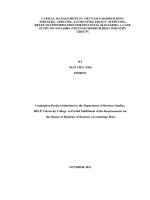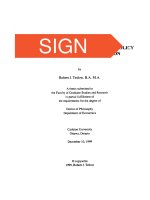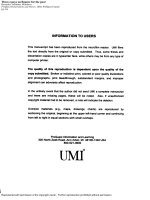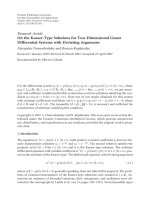Two essays on the accounting treatment for information technology expenditures
Bạn đang xem bản rút gọn của tài liệu. Xem và tải ngay bản đầy đủ của tài liệu tại đây (2.44 MB, 96 trang )
TWO ESSAYS ON THE ACCOUNTING TREATMENT FOR INFORMATION TECHNOLGY
EXPENDITURES
TWO ESSAYS ON THE ACCOUNTING TREATMENT FOR INFORMATION TECHNOLOGY
EXPENDITURES
A dissertation submitted in partial fulfillment
of the requirements for the degree of
Doctor of Philosophy in Accounting
By
Kimberly Swanson Church
Pittsburg State University
Bachelor’s of Business Administration, 1998
Kansas State University
Master’s of Accountancy, 2002
December 2010
University of Arkansas
UMI Number: 3428494
All rights reserved
INFORMATION T
O ALL USERS
The quality of this reproduction is dependent upon the quality of the copy submitted.
In the unlikely event that the author did not send a complete manuscript
and there are missing pages, these will be noted. Also, if material had to be removed,
a note will indicate the deletion.
UMI 3428494
Copyright 2
010
by ProQuest LLC.
All rights reserved. This edition of the work is protected against
unauthorized copying under Title 17, United States Code.
ProQuest LLC
789 East Eisenhower Parkway
P.O. Box 1346
Ann Arbor, MI 48106-1346
This dissertation is approved for
Recommendation to the
Graduate Council
Dissertation Director:
_______________________________________________
Dr. Vernon Richardson
Dissertation Committee:
_______________________________________________
Dr. Gary Peters
_______________________________________________
Dr. Rodney Smith
_______________________________________________
Dr. Deborah Armstrong
DISSERTATION DUPLICATION RELEASE
I hereby authorize the University of Arkansas Libraries to duplicate this dissertation when
needed for research and/or scholarship.
Agreed _________________________________________________
Kimberly Swanson Church
Refused ________________________________________________
Kimberly Swanson Church
ABSTRACT
The current accounting measurement and reporting system is ill-equipped to provide
intangible investment information that is decision useful for stakeholders in the information
economy. Potentially relevant intangible items are not reported on the balance sheet, since
current standards mandate the immediate expensing of these intangible items. Presumably
FASB’s uncertainty with the fundamental issues of extent and timing of future benefits to the firm
has led to concerns with relevance, reliability, and objectivity of capitalizing some intangibles,
which results in potential long term value generating expenditures being immediately expensed
on the income statement. Prior research has demonstrated extent and timing of some income
statement intangibles, such as advertising and research and development, however the potential
value of IT intangibles as an asset has not been investigated.
This dissertation addresses issues on the accounting treatment for information
technology (IT) expenditures and includes two parts. The first part contains an essay discussing
the business value of IT expenditures using a rational economic argument to propose the
capitalization of IT expenditures as an appropriate accounting treatment. The second part is
composed of an essay that proposes statistically reliable amortization rates for intangible IT
expenditures followed by a value analysis of the proposed accounting treatment.
This dissertation provides information about the business value of capitalized information
technology. The results of this study could help standard setters (FASB, IASB), other policy
makers and regulators (SEC, Fed Res Board), firm managers, and financial statement users
refine standards for intangible assets, specifically information technology.
v
ACKNOWLEDGEMENTS
Special thanks are due to my dissertation committee for their selfless service and
commitment to the completion of my dissertation. Vernon Richardson provided an experience
that would afford me some of life’s biggest lessons and an unquestionable appreciation for what
has been accomplished. Rodney Smith served as a mentor in both teaching and research from
the first day I stepped foot on campus until the last day he stepped foot off campus. Deborah
Armstrong taught me the true meaning of “paying it forward”, a legacy I continue to participate in
to this day. Gary Peters offered a friendly face and solid advice on a moments notice. I am better
for every day, every challenge, and every success this opportunity provided.
Also, special thanks go out to the faculty and staff that support the efforts of graduate
students in the Walton College of Business. Dean Koski’s assistance in navigating the
benchmarks necessary for degree completion, Nancy Fondren’s patience and ability to interpret
forms and deadlines, Sandy Kizer and team’s willingness to drop everything to keep us moving
forward, and Suzanna Hicks’ support that can never be replicated. These statements would not
be complete without mentioning the department chairs and PhD coordinators that served during
my time at the University of Arkansas, each of which brought unique perspectives to how this
process should be completed. Dr Pincus supported three wives and mothers (how can we thank
you?). Dr Callahan had the foresight to bring together the “three musketeers”. Dr Finn kept
pushing us toward the finish line. Dr Myers reset the process and made completion of this
document possible.
These acknowledgements are not limited to the select few listed by name. There are
many more people, whose roles large and small made this document a reality. You are not
forgotten.
vi
DEDICATION
This dissertation is dedicated to the village it took to raise this PhD student. My family
supported me and covered for me so that I could pursue my dream. Eric, Tanner, Kyndel, Mom,
Dad, Stacey, and Uncle Dan, we did it!
Graduate school friends are the ones that walk through the trenches together. They are a
group bound together by a common experience, never to be forgotten. These six women will be
my sisters for as long as I am on this earth. On days when I thought I could not walk another step
forward, you all pushed, pulled, or carried me until I regained my strength. Julie’s altruistic acts
will be rewarded for a lifetime to come. Angela’s unwavering and unconditional support brings a
smile to my face each morning. Maureen’s introduction to the Lord serves me to this day. Elyria’s
ability to share the meaning of prayer overwhelms me with its power, especially when it includes
her circle. Pam’s willingness to listen tirelessly to my ideas will always be reciprocated. Georgia
just speaks my language. You are my biggest fans!
vii
TABLE OF CONTENTS
I. CHAPTER 1 1
A. Title 1
B. Introduction 2
C. References 4
II. CHAPTER 2 5
A. Title 5
B. Abstract 6
C. Introduction 7
D. Background 9
E. Economic Theory 13
F. Balance Sheet Perspective 19
G. Conclusion 22
H. Appendix 24
I. References 26
III CHAPTER 3 28
A. Title 28
B. Abstract 29
C. Introduction 30
D. Background and Motivation 34
E. Hypotheses Development 38
F. Research Design 43
G. Sample Description 48
H. Empirical Findings 50
I. Conclusion 54
J. Subsequent Analysis 55
K. Summary 61
L. Tables 63
M. References 76
IV. CHAPTER 4 83
A. Title 83
B. Conclusion 84
C. Reference 86
1
Chapter 1
TWO ESSAYS ON THE ACCOUNTING TREATMENT FOR INFORMATION TECHNOLGY
EXPENDITURES
2
I. INTRODUCTION
This dissertation addresses issues on the accounting treatment for information
technology (IT) expenditures and includes two parts. The first part contains an essay discussing
the business value of IT expenditures using a rational economic argument to propose the
capitalization of IT expenditures as an appropriate accounting treatment. The second part is
composed of an essay that proposes statistically reliable amortization rates for intangible IT
expenditures followed by a value analysis of the proposed accounting treatment.
The current accounting measurement and reporting system is ill-equipped to provide
intangible investment information that is decision useful for stakeholders in the information
economy. Potentially relevant intangible items are not reported on the balance sheet, since
current standards mandate the immediate expensing of these intangible items. Presumably
FASB’s uncertainty with the fundamental issues of extent and timing of future benefits to the firm
has led to concerns with relevance, reliability, and objectivity of capitalizing some intangibles,
which results in potential long term value generating expenditures being immediately expensed
on the income statement. Prior research has demonstrated extent and timing of some income
statement intangibles, such as advertising and research and development, however the potential
value of IT intangibles as an asset has not been investigated.
The first study investigates the business value of IT. The business value of IT refers to
the organizational performance impacts of IT expenditures including productivity enhancements,
profitability improvements, market value, and other measures of firm performance (Melville et al,
2004). Researchers in the last decade have found large productivity improvements associated
with IT, as well as evidence that IT contributes to the market value of the firm. However, the
question still remains whether IT has a positive impact on profitability. The focus of this essay is
to establish a theoretical link between productivity, profitability, and market value, resulting in a
rational economic argument for capitalizing IT intangibles. Applying methods based on economic
theory, this paper examines the rationally managed, profit maximizing behavior of firms in
competitive markets. This analysis suggests firms will optimize production plans and precisely
measure IT costs as assets to maximize profits and stock market value.
3
The second essay empirically examines the asset behavior of IT expenditures, proposes
a useful life and amortization rate estimates for a capitalization treatment of IT intangibles, and
then examines the value of the capitalized intangible IT information to investors by associating
contemporaneous equity market values and intertemporal stock returns with constructed IT book
value amounts. The sample is comprised of 1633 U.S. firm year observations from
InformationWeek 500 surveys for the period 1991-1997 and industry spending information from
InformationWeek 500 surveys for the period 1998-2006. The results of this analysis demonstrate
the intangible component of IT expenditures is associated with future operating income, which is
then used to establish a proposed amortization rate based upon the identified positive association
between IT and earnings in future periods. A positive and significant association exists between
the book and market values in a contemporaneous setting, consistent with information valued by
investors for decision making. A positive and significant association exists between the
constructed intangible component of IT expenditures and future returns, consistent with investor
mispricing due to lack of useful and or available information for decision making. These results
imply the investor is valuing the IT expenditure as a balance sheet asset, yet is unable to
completely undo potentially inappropriate income statement treatment of the IT expenditure.
This dissertation provides information about the business value of capitalized information
technology. The results of this study could help standard setters (FASB, IASB), other policy
makers and regulators (SEC, Fed Res Board), firm managers, and financial statement users
refine standards for intangible assets, specifically information technology.
4
REFERENCES
Melville, N., K. Kraemer, and V. Gurbaxani. 2004. Review: Information technology and
organizational performance: An integrative model of IT business value. MIS Quarterly 28 (June):
283-322.
5
Chapter 2
THE BUSINESS VALUE OF IT: A RATIONAL ECONOMIC ARGUMENT FOR CAPITALIZING
IT EXPENDITURES
6
ABSTRACT
Researchers in the last decade have found large productivity improvements associated
with Information Technology (IT), as well as evidence that IT contributes to the market value of
the firm. However, the question still remains whether IT has a positive impact on profitability. The
focus of this paper is to establish a theoretical link between productivity, profitability, and market
value, resulting in a rational economic argument for capitalizing IT intangibles. Applying methods
based on economic theory, this paper examines the rationally managed, profit maximizing
behavior of firms in competitive markets. This analysis suggests firms will optimize production
plans and precisely measure IT costs to maximize profits and stock market value.
7
I. INTRODUCTION
Capital investment expenditures on Information Technology (IT), such as hardware and
peripherals, represented $204.9 billion in spending for firms in the United States in 2008, (U.S.
Census Bureau 2010).
1
The business value of IT refers to the organizational performance impacts of IT
expenditures including productivity enhancements, profitability improvements, market value, and
other measures of firm performance (Melville et al. 2004). Recent studies using production theory
(Brynjolfsson and Hitt 1996, 2000, 2003) event studies (Dos Santos et al. 1993; Im et al. 2001;
Dehning et al. 2003) and valuation models (Bharadwaj et al. 1999; Brynjolfsson et al. 2002) have
overcome the “productivity paradox” by relating productivity and market value of the firm to IT
capital or spending (Brynjolfsson 1993; Brynjolfsson and Yang 1999). Although these studies
contribute evidence regarding the contribution of IT to the overall business value of the firm, they
have yet to establish a positive significant association between IT and the earnings component of
Commensurate with rapid technological change and the increasing
importance of IT as a factor input, this spending number has grown steadily, up 15.04 percent
from the prior year alone, despite decreasing prices (Gurbaxani et al. 2000; U.S. Census Bureau
2010). Researchers in the last two decades have found productivity improvements associated
with these large expenditures, as well as evidence that IT contributes to the market value of the
firm (Brynjolfsson 1993; Brynjolfsson and Yang 1999); however there lacks a clear consensus on
whether IT positively affects profitability. A major reason for the lack of consensus is the absence
of a theoretical framework outlining the mechanism by which IT influences profitability. The
debate is further complicated by the limited data available with which to evaluate IT investment
and its effect on profits. The focus of this paper is to institute a theoretical link between the
components of business value and provide a rational economic argument for the necessary
capitalizing of additional IT expenditures to establish a positive association with the earnings
component.
1
“The Information and Communication Technology Survey (ICTS), a supplement to the Annual Capital
Expenditures Survey (ACES), was created in response to economic data user and policy maker concerns
about the lack of available data,” Information and Communication Technology, U.S. Census Bureau, May
10, 2010.
8
business value. Business executives are better able to allocate resources within the firm if they
have a better understanding of the relationship between IT investment, productivity, profitability,
and market value.
The economic theory of production has been used extensively by diverse disciplines to
assess the business value of IT investments (Hitt and Brynjolfsson 1996). Using econometric
techniques, value-added firm output accompanying a set of IT inputs is used to estimate marginal
product, which is the increase in value-added associated with a 1 percent increase in IT
expenditures. Most IT investment studies, even those adjusted for obsolescence; find higher
marginal product for IT investments than for other capital investments (Dedrick et al. 2003).
These excess returns are contrary to results of microeconomic theory that firms invest so that all
investments pay the same risk-adjusted return at margin. Given high marginal returns, prior
studies imply firms are systematically under investing in IT relative to other capital investments
(Lee and Barua 1999; Brynjolfsson and Hitt 2003).
A proposed explanation for this observed under investing is that the calculations are
made using IT investment measures that are plagued with measurement error (Brynjolfsson
1993; Melville et al. 2004). Since profit maximizing firms should not systematically under invest,
some authors have suggested the observed anomaly results from IT investment that is observed
with measurement error. This measurement error is introduced when data are taken from
financial statements that have been filtered through Generally Accepted Accounting Principles
(GAAP). Accounting standards can distort the quality of reported information in an attempt to
improve the ability to forecast using accrual measures of periodic firm performance.
Traditionally, return on assets (ROA), return on equity (ROE), and return on sales (ROS) have
been used in the literature to measure profitability improvements of the firm (Dehning and
Richardson 2002; Revsine et al. 2005) A limitation of these measures is that they are dependent
upon accounting numbers subject to GAAP, which mandates expensing a majority of IT
expenditures, leading to negatively biased financials and inaccurate performance ratios (Amir and
Lev 1996). The “mismeasurement” of accounting numbers used in performance measures might
explain the disconnect that exists between the components of business value, specifically the
9
inconsistent results between IT investments and profitability (Brynjolfsson 1993). This study
utilizes production theory from the business value of IT literature to show how inappropriate
accounting treatment of IT expenditures can lead to the previously observed conclusions and
establish a theoretical association between IT and profitability.
The remainder of this study is organized as follows. Section II draws from accounting,
economics, and information systems literature to link theoretically the components of IT business
value. Section III utilizes competitive market assumptions to apply economic theory to the
business value of IT. Section IV develops a theoretically justified argument to capitalize additional
IT expenditures using the mismeasurement dilemma from a balance sheet perspective. Section V
concludes the discussion of IT business value, identifies limitations, and provides the
contributions of this study to a diverse set of literature.
II. BACKGROUND
Our understanding of the overall relationship between IT and business value has been
enriched by the diversity of ideas and findings from several academic disciplines, including
information systems, economics, accounting, strategy, and operations research (Melville et al.
2004). Numerous studies have assessed the positive impact of IT investments on both
productivity and market value (Brynjolfsson and Hitt 1993; Dos Santos et al. 1993; Brynjolfsson
and Yang 1999; Im et al. 2001; Dehning et al. 2003). However, an appurtenant consequence of
separate research streams has hampered the aggregation of ideas and findings, making it difficult
for those outside of IT business value to understand what has been learned or, more importantly,
which questions remain unresolved (Chan 2000). It is therefore necessary to provide a normative
approach to cumulate the theoretical foundation of this work to deduce the relationship that exists
between the components of business value in an attempt to establish a positive significant
relationship between IT investments and profitability.
The business value of IT refers to the organizational performance impacts of IT
expenditures including productivity enhancements, profitability improvements, increased market
value, and other measures of firm performance (Melville et al. 2004). Prior literature has related
IT to productivity and market value without establishing a relationship between IT and profitability,
10
see Figure 1. Economics can be used to overcome the disconnect that exists between these
components of business value by theoretically establishing the relationship that exist between
optimized productivity plans, maximized profits, and the present value of future profit streams.
Productivity
Economic theory addresses the issue of business productivity. Production economics
optimizes a set of relevant inputs, such as IT expenditures, needed to produce desired firm
output, such as firm performance. In addition, this theory also identifies the structural
relationships and technological constraints that exist among these variables (Melville et al. 2004).
A production function describes the constraints by measuring the maximum output possible from
a given combination of inputs (Varian 1999). When combined with the constraints the firm faces,
such as fixed quantities of some resources, resources prices, and product demand, the firm is
able to determine the level of output to produce and inputs to employ to maximize profits. The
present value of maximized profits represents the total stock market value a firm is expected to
generate. Thus, profit maximizing firms will operate where productivity is at a maximum, and
Figure 1
Business Value of IT Expenditures
IT Expenditures
Hardware, Software,
Communication
Network, Ideas, User
Needs, and Strategy
Firm Productivity
),( outputinputf
Firm Profitability
)cos,( trevenuef
Market Value
),,( timeratefuturef
π
Business Value of IT
11
technological changes that allow the firm to improve productivity, i.e. produce more output with
the same inputs or produce the same output with fewer inputs, should lead to higher profits
(Dedrick et al. 2003).
The structural relationships that optimize relevant firm inputs and outputs are production
functions, such as Cobb-Douglas, which utilize mathematical specifications to describe the
transformation of various inputs to outputs (Varian 1999; Melville et al. 2004). It is possible to
estimate the contribution of each input to total output in terms of the gross marginal benefit, which
represents the rate of return on the last dollar invested. A rationally managed firm will keep
investing in inputs until the output it generates adds no more value than the cost of the input (Hitt
and Brynjolfsson 1996; Kudyba 2004).
Most production functions, including the Cobb-Douglas, allow some degree of
substitution among inputs, including IT. The degree to which inputs can be substituted for each
other in the production process will depend on the technology and is measured as the elasticity of
substitution. When the technology has a diminishing rate of marginal substitution, the profit
maximizing firm should choose an input combination such that the price ratio of the resources
equals the marginal rate of substitution ratios and adjust input use when input prices change;
such is the case with the declining price of IT (Gurbaxani et al. 2000).
Profitability
A basic assumption of firm behavior is that a firm chooses actions to maximize profits or
minimize costs for the optimal level of production (Lee and Barua 1999). These actions are
constrained by technology and the market. Technological constraints are concerned with the
feasible combination of inputs and outputs from a specific production plan, such as the maximum
level of output possible from one week of labor. Market constraints are concerned with the effects
of outside agent actions on the firm, such as the price consumers are willing to pay or suppliers
are willing to accept.
Firms produce n units of y outputs at price p and use m units of x inputs at price w. The
first term in the expression represents revenues, how much a firm sells of various outputs times
12
the price of each output, and the second term in the expression represents costs, how much a
firm uses of each input times the price of each input. Profits are then
∑ ∑
− =
−=
n
i
m
i
iiii
xwyp
1 1
π
defined as revenues minus costs. There are many variations in the use of this term, of which two
will be defined. Economic profits consider the opportunity costs of all inputs in the above
equation. Whereas, accounting profits typically require the use the historical cost of only inputs
that required a monetary outlay (Varian 1999).
The basic principles of profit maximization involve minimizing the cost function (C = min
wx). Production plans determine the level of output and inputs necessary to
xy,
max
py > wx
s.t. y = f(production)
maximize profits. The optimal choice of production plan is reached when the marginal revenue of
output is equal to the marginal cost or the marginal revenue product of an input is equal to the
marginal resource cost (Varian 1999). Either way, a firm that experiences productivity
improvements will generally observe higher profitability, by enabling cost advantages (Dedrick et
al. 2003).
Market Value
It is assumed profit maximizing firms have employed the optimal production function to
maximize profits. The production process a firm utilizes often goes on for many periods. Inputs,
such as capital assets, in place at time t contribute to outputs, such as profits, in future periods.
The concept of present value can be used to value the production decision for flows of cost and
revenue by introducing interest rates to define a natural price of consumption over time. The
present value of firm profits represents the total stock market value a firm is expected to
generate.
Shareholders generally want the firm to choose production processes that maximize the
stock market value of the firm. Regardless of shareholder tastes and preferences at different
times, they will always prefer an endowment with a higher present value. By maximizing profits
13
and stock market value, the firm increases shareholder budgets and acts in the best interest of
both the shareholder and firm. Thus, the profit maximization goal of the competitive firm becomes
the same as the goal to maximize shareholder wealth (Varian 1999).
III. ECONOMIC THEORY APPLIED TO THE BUSINESS VALUE OF IT
The production theory approach measures the marginal benefits of IT investments. This
is closely associated with the process of business value creation. If IT investments are
productive, then less input is required to create more output, which should lead to improved
profitability if demand for the product does not change, and ultimately increasing market value.
When assuming a competitive market, the firm outcome can be technical efficiency and the
pursuit of profit maximization and cost minimization by optimizing the choice of production plans.
Due to its simplicity and flexibility, the Cobb-Douglas production function is commonly used in IT
literature as a fundamental economic measure of IT contribution to firm value and to motivate
theoretically the discussion of business value (Brynjolfsson 1993; Hitt and Brynjolfsson 1996;
Barua and Lee 1997; Gurbaxani et al. 1997; Mukhopadhyay et al. 1997; Lee and Barua 1999;
Gurbaxani et al. 2000; Davamanirajan et al. 2002; Kudyba 2004; Pavlou et al. 2005; Lin and
Shao 2006; Wagner and Weitzel 2007).
To build a theoretical framework, assume the firm is operating in a competitive market. A
perfectly competitive market has a large number of independent firms offering a homogeneous
product without barriers to entry. Although this type of market is rare, the model will provide a
generalization framework that can be used for evaluating the business value of IT. Most
importantly, prices are exogenous variables for firms in competitive markets. Since demand is
perfectly elastic at market price, e.g. price = marginal revenue (p = MR), the profit maximizing
competitive firm will produce where price equals marginal product (p=MR=MP).
The following assumptions will be made to apply the Cobb-Douglas production function to the
business value of IT for a perfectly competitive firm:
• Firms employ resources in perfectly competitive markets, e.g. price takers.
• Firms sell products in competitive markets at price = 1.
14
• Firms initially choose y (output), K (capital leases), L (labor contracts), and T (IT
expenditures), so that profit is maximized.
• Once the initial decision is made, K & L, are fixed at k to evaluate the usage of T.
• The fixed cost of k is
LPKPx
LK
+=
.
• Firms have production technology, such that
βα
Tky =
, where k is a composite
measure of K & L. Also,
10 <<
α
and
10 <<
β
.
Productivity
To evaluate the contribution of IT to productivity, the optimized choice of the firm to
operate at point A where they produce
1
y
units of output using
k
and
1
T
as inputs is shown in
Figure 2. The marginal product of T is positive, but diminishing. The firm employs T so that the
marginal product of T will equal the price of T. Over time the firm is locked in to
k
labor contracts
and capital leases while input price of T falls from
1
P
to
2
P
such that
12
PP
γ
=
(
10 <<
γ
). As a
result, the firm spends the same total budget dollars for an increased input quantity of T. Now, the
firm will operate at point B and produce
2
y
units of output using
k
and
2
T
as inputs, where
k
is
fixed.
15
Figure 2
Optimized Cobb-Douglas Production Function for IT Expenditures
βα
Tky =
y firm output
k composite measure for quantity of capital and labor
T quantity of IT
A optimal quantity of k and T firm will operate with before price declines
B optimal quantity of k and T firm will operate with after price declines
Marginal Product of T
1−
=
∂
∂
βα
β
Tk
T
y
, marginal product
0>
∂
∂
T
y
, positive
0
2
2
<
∂
∂
T
y
, but diminishing marginal product of T
Firm will employ T so that
TT
PMP =
.
When operating at point A, the firm’s productivity may be measured in several ways. One
measurement is to consider output per worker, where output is divided by
k
, the composite
2
T
1
T
B
A
k
Q
T
k
1
y
2
y









